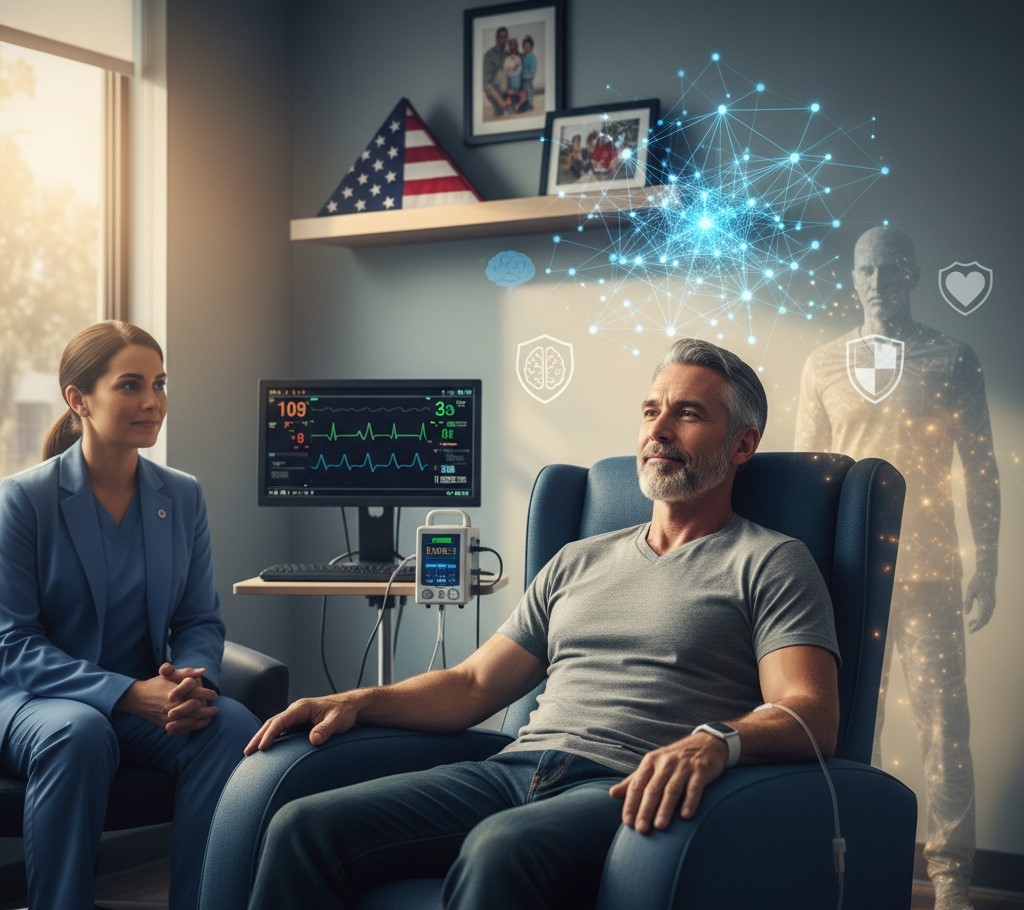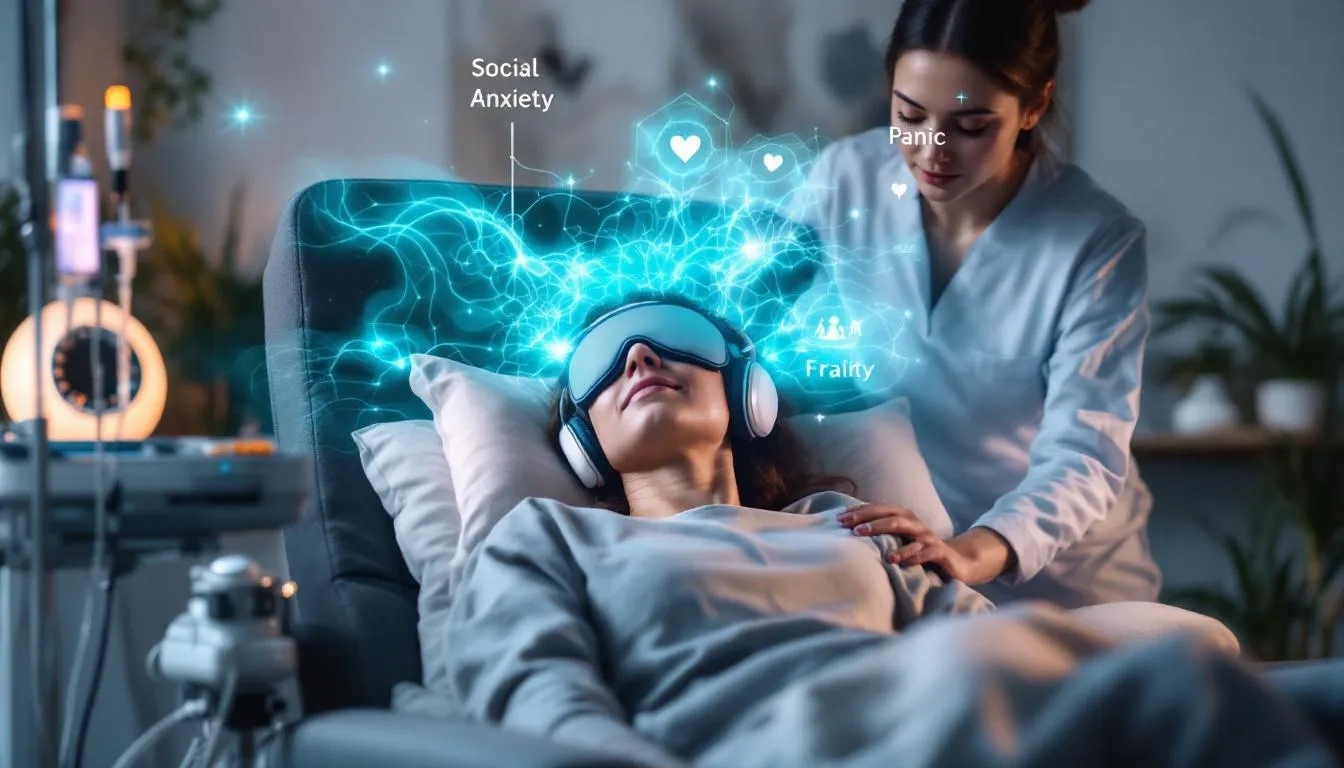Ketamine for anxiety is gaining attention as a possible fast-acting option for people with hard-to-treat conditions.
Anxiety disorders are among the most common mental health challenges, ranging from persistent worry in generalized anxiety disorder (GAD) to intense fear in social anxiety disorder (SAD) and sudden panic attacks.
Standard treatments like cognitive-behavioral therapy and SSRIs don’t work for everyone; nearly half of people with GAD see little relief.
This gap has sparked interest in ketamine—a medication originally developed as an anesthetic—as a potential breakthrough.
In this article
- How Ketamine Works for Anxiety
- Evidence for Generalized Anxiety Disorder (GAD)
- Ketamine for Social Anxiety Disorder
- Emerging Data on Panic Disorder and Specific Phobias
- Safety Profile and Side Effects
- Mechanisms Behind the Antianxiety Effects
- Choosing a Ketamine Clinic and the Role of Integration
- Practical Considerations for Patients
- Future Directions and Cautions
- Ready for Relief? Take the Next Step
How Ketamine Works for Anxiety
Ketamine is best known as an anesthetic, but low doses can rapidly relieve severe depression. Unlike benzodiazepines, which calm the brain by enhancing the neurotransmitter GABA, ketamine blocks N‑methyl‑D‑aspartate (NMDA) receptors.
This blockage causes a surge of the excitatory neurotransmitter glutamate and activates AMPA receptors.
The cascade boosts brain-derived neurotrophic factor (BDNF) and stimulates the growth of new connections between neurons, potentially reversing stress-related changes in the hippocampus and prefrontal cortex.
Early studies suggest ketamine also strengthens GABA’s calming effects. Together, these actions may rapidly quiet overactive circuits that drive anxiety, often within hours or days.
Evidence for Generalized Anxiety Disorder (GAD)
Research on ketamine for GAD is limited but growing. A 2022 systematic review analyzed trials in which people with treatment‑resistant depression (TRD) and co‑occurring anxiety received six intravenous infusions (0.5 mg/kg) over 12 days.
Anxiety ratings on the Hamilton Anxiety Scale dropped below clinical levels by days 13 and 26, and depressive symptoms also improved.
The same review examined weekly esketamine infusions and found that only about half of the participants showed improvement.
Overall, repeated infusions reduced irritability and panic, but benefits for GAD tended to be transient, often lasting about a week.
Dosing and Delivery
Higher doses (around 1 mg/kg) appear to provide greater anxiety reduction than the standard 0.5 mg/kg dose, but they also bring more side effects.
Most clinics, therefore, start low and adjust based on response. Researchers are exploring different delivery methods.
Subcutaneous injections and oral formulations show promise; a small hospice study reported notable anxiety and depression relief from daily oral ketamine with few side effects, and ascending subcutaneous doses led to response rates of 66–83 percent.
Ketamine for Social Anxiety Disorder
Social anxiety disorder causes an intense fear of social situations. Standard therapies often leave one‑third to one‑half of sufferers without adequate relief.
A landmark double‑blind, placebo‑controlled crossover trial recruited 18 adults with SAD and compared a 0.5 mg/kg intravenous ketamine infusion with saline.
Ketamine significantly reduced scores on the Liebowitz Social Anxiety Scale. Within two weeks, 33 percent of participants met the response criterion compared with 0 percent on placebo, and 88.9 percent reported decreased anxiety on a visual analog scale versus 52.9 percent on placebo.
These benefits were short‑term, suggesting ketamine may need to be repeated or paired with therapy for lasting results.
Open‑label studies have reported that multiple subcutaneous injections produced relief lasting up to three months with improvements in social and work functioning, though the small sample sizes and lack of placebo control mean these findings should be interpreted cautiously.
Emerging Data on Panic Disorder and Specific Phobias

Panic disorder involves sudden attacks of overwhelming fear accompanied by physical symptoms.
Evidence is preliminary, but a 2022 review reported that single ketamine infusions reduced panic and irritability in patients with generalized and social anxiety disorders.
The anxiety‑reducing effects typically lasted about a week, after which symptoms gradually returned.
Specific phobias may also respond to ketamine. A small study using subcutaneous injections lowered agoraphobia ratings—fear of places where escape might be difficult.
A systematic review found that ketamine reduced anxiety symptoms in GAD and SAD, with higher doses providing greater relief and effects lasting up to two weeks.
Larger trials are underway to clarify ketamine’s role in panic disorder and specific phobias.
Safety Profile and Side Effects
Ketamine is generally safe when administered under medical supervision. The most common side effects are headache, nausea, dizziness and rapid heartbeat, especially at higher doses.
These symptoms peak around 30 minutes after infusion and usually resolve within an hour. Dissociation—a dreamlike sensation—is also common but short‑lived; it typically vanishes by 60 minutes.
Some people should avoid ketamine. It isn’t recommended for those who are pregnant or breastfeeding, have uncontrolled high blood pressure, heart disease, psychosis or a history of substance misuse.
Even at low doses, side effects like nausea, lightheadedness and increased blood pressure can occur, so patients need monitoring and should not drive until the day after treatment.
Ketamine’s abuse potential appears low when administered via supervised infusion, but long‑term studies are needed to better understand tolerance and dependence.
Mechanisms Behind the Antianxiety Effects
Ketamine’s downstream effects extend beyond NMDA receptor blockade. Its metabolites stimulate AMPA receptors and mTOR pathways, promoting synapse formation and increasing serotonin and norepinephrine.
These actions may explain why ketamine enhances neuroplasticity and mood so quickly. Animal studies suggest the R‑ketamine enantiomer might offer longer‑lasting benefits with fewer side effects, though human data are limited.
Choosing a Ketamine Clinic and the Role of Integration
Ketamine is a powerful psychoactive substance and should only be administered at a reputable clinic under the supervision of licensed healthcare professionals.
The American Society of Ketamine Physicians advises that clinics have board‑certified physicians on staff, conduct thorough screening to ensure patients are appropriate candidates, and provide psychological support before, during and after treatment.
Clinics should avoid making exaggerated claims; ketamine isn’t a “cure” and works best when combined with therapy and lifestyle changes.
Ketamine can create a window of decreased fear that makes the therapy more effective.
The Anxiety & Depression Association of America notes that ketamine’s receptor interactions and safety profile make it a promising option for people with treatment‑resistant anxiety and depression and may reverse damage to the hippocampus and prefrontal cortex.
However, they stress that ketamine should be paired with therapy and careful follow‑up. Many clinics, including Daytryp’s structured sessions to help patients process insights and incorporate them into daily life.
Practical Considerations for Patients
If you’re considering ketamine for anxiety, keep these points in mind:
- Screening: A thorough medical and psychiatric evaluation ensures ketamine is appropriate and rules out conditions like uncontrolled hypertension or psychosis.
- Dosing and monitoring: Most protocols use 0.5 mg/kg IV delivered over 40 minutes. Higher doses may enhance response but increase side effects. After each infusion you’ll remain under observation for about an hour and will need someone to drive you home.
- Integration: Pairing ketamine with therapy or integration coaching helps translate insights into lasting change.
Future Directions and Cautions
Research on ketamine for anxiety disorders is still emerging. Most studies have small sample sizes and varied dosing regimens, so results should be interpreted cautiously.
Scientists are exploring whether compounds like (R)-ketamine or metabolites such as (2R,6R)-hydroxynorketamine could provide longer‑lasting relief with fewer side effects.
There is also growing interest in combining ketamine with psychotherapy and digital tools, as well as developing maintenance schedules that prevent relapse without causing tolerance.
Finally, ketamine isn’t suitable for everyone. People with uncontrolled medical conditions, pregnancy, or substance use disorders should avoid it.
Even for appropriate candidates, ketamine should be approached as one tool among many—a catalyst for healing rather than a standalone cure.
Always consult a qualified clinician before pursuing treatment.
Ready for Relief? Take the Next Step
If anxiety has taken hold of your life and conventional therapies haven’t provided the relief you need, ketamine therapy may offer a fresh path forward, combining medical expertise with compassionate support to ensure a safe, comfortable experience.
Our team is committed to helping you explore the roots of your anxiety, repair neural pathways, and build resilience through integrative practices.
Find Your Calm Today
Curious to see whether ketamine could help you or a loved one?
Reach out to schedule your intake with our licensed clinicians. We’ll guide you through every step—from screening and dosing to integration—so you can decide with confidence.
A calmer, more connected life might be closer than you think.










 Daytryp Health has taken
Daytryp Health has taken  The
The 